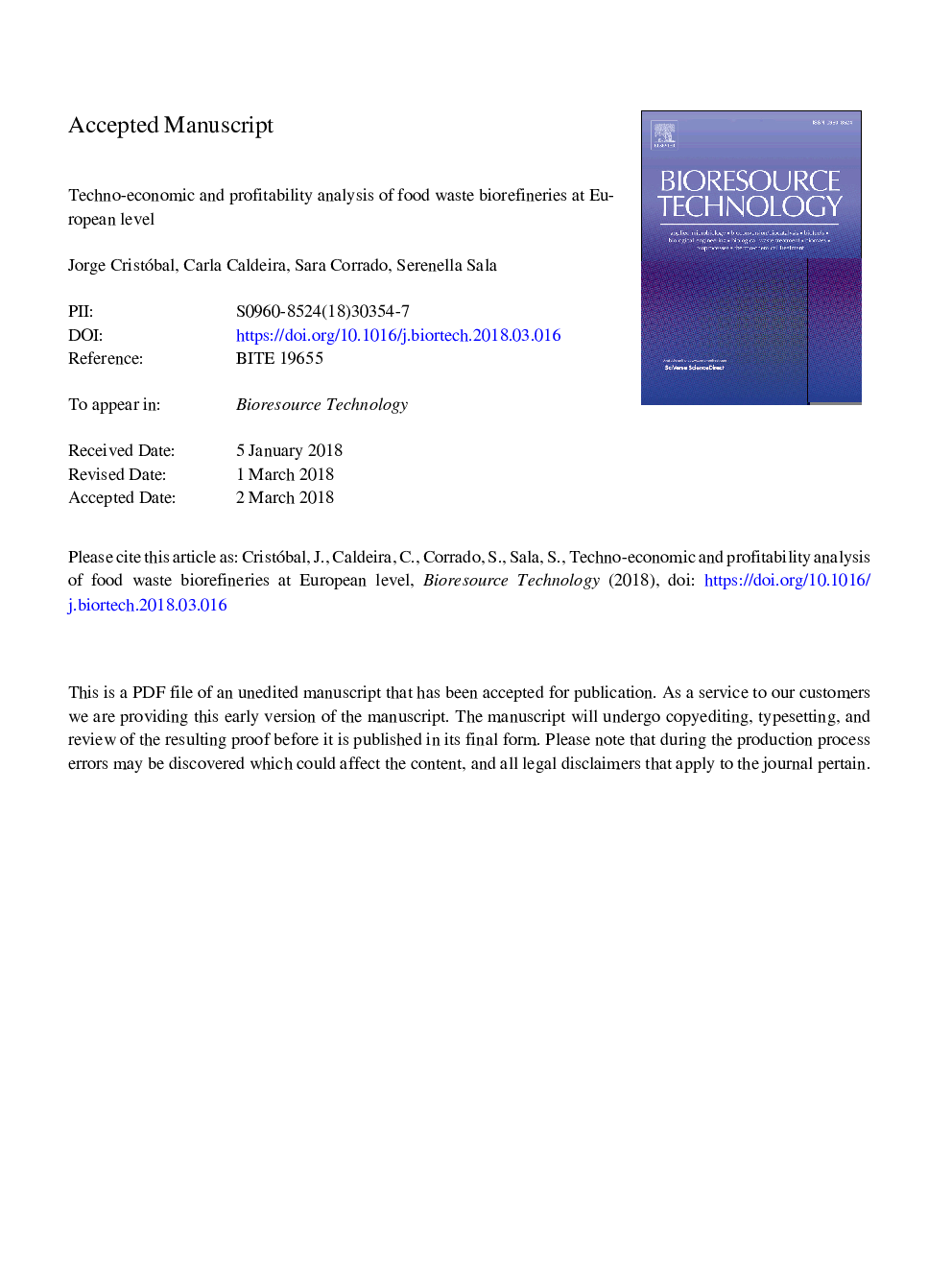| کد مقاله | کد نشریه | سال انتشار | مقاله انگلیسی | نسخه تمام متن |
|---|---|---|---|---|
| 7067379 | 1459884 | 2018 | 41 صفحه PDF | دانلود رایگان |
عنوان انگلیسی مقاله ISI
Techno-economic and profitability analysis of food waste biorefineries at European level
ترجمه فارسی عنوان
تجزیه و تحلیل تکنو اقتصادی و سودآوری فاضلاب زباله های مواد غذایی در سطح اروپا
دانلود مقاله + سفارش ترجمه
دانلود مقاله ISI انگلیسی
رایگان برای ایرانیان
کلمات کلیدی
ترجمه چکیده
هدر غذا یک منبع بالقوه برای تولید مواد با ارزش افزوده است که جایگزین استفاده از آنها می شود. با این حال، استفاده از زباله های مواد غذایی به عنوان مواد اولیه در کارخانجات زباله هنوز در مراحل اولیه توسعه است و مطالعات انجام شده برای ارزیابی حیاتی اقتصادی آن در مقیاس وسیعی در ادبیات کم است. این مقاله تجزیه و تحلیل تکنولوژیکی و سودآوری 4 فاضلاب زباله های مواد غذایی را که از مواد زائد گوجه فرنگی، سیب زمینی، نارنجی و پردازش زیتون به عنوان مواد اولیه استفاده می کنند، ارائه می دهد. این مطالعه شامل ارزیابی مقادیر بالقوه موجود در جریان جریانهای زباله در اروپا می شود. با توجه به سطح آمادگی کم فن آوری این نوع کارخانجات زیستی، یک روش غربالگری برای تخمین هزینه های سرمایه گذاری و تولید و نیز دو نسبت سودآوری (بازده سرمایه گذاری و زمان بازپرداخت) تصویب شد. نتایج نشان می دهد که همه مواد اولیه زباله پتانسیل مشابهی ندارند. گزینه های سودآور تر هستند مربوط به اجرای گیاهان کمتر است، یعنی تمرکز تولید و سرمایه گذاری در مقیاس اقتصادی در حالی که در معرض خطر افزایش اثرات خارجی قرار دارد، مثلا به دلیل تدارکات مواد اولیه.
موضوعات مرتبط
مهندسی و علوم پایه
مهندسی شیمی
تکنولوژی و شیمی فرآیندی
چکیده انگلیسی
Food waste represents a potential source to produce value-added materials replacing the use of virgin ones. However, the use of food waste as feedstock in biorefineries is still at an early stage of development and studies assessing its economic viability at large scale are lacking in the literature. This paper presents a techno-economic and profitability analysis of four food waste biorefineries that use wastes from tomato, potato, orange, and olive processing as feedstock. The study includes the assessment of potentially available quantities of those waste flows in Europe. Due to the low technology readiness level of this kind of biorefineries, a screening methodology to estimate the investment and manufacturing costs as well as two profitability ratios (the return on investment and the payback time) was adopted. Results show that not all the waste feedstocks have the same potential. The most profitable options are those related to implementing fewer plants, namely concentrating the production and capitalising on economies of scale while being at risk of increasing externalities, e.g. due to logistics of the feedstocks.
ناشر
Database: Elsevier - ScienceDirect (ساینس دایرکت)
Journal: Bioresource Technology - Volume 259, July 2018, Pages 244-252
Journal: Bioresource Technology - Volume 259, July 2018, Pages 244-252
نویسندگان
Jorge Cristóbal, Carla Caldeira, Sara Corrado, Serenella Sala,
